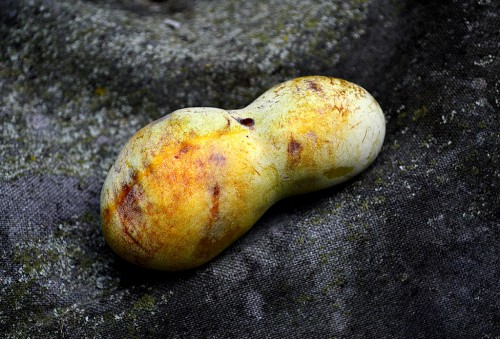 Mother came in from hanging up the laundry in the back yard bearing something the looked like a soft peanut on steroids. She said it was a pawpaw, known formally as an Asimina Triloba. It’s a distant relative of the Custard Apple, and it’s considered the largest edible fruit native to America. (Click on the photos to make them larger.)
Mother came in from hanging up the laundry in the back yard bearing something the looked like a soft peanut on steroids. She said it was a pawpaw, known formally as an Asimina Triloba. It’s a distant relative of the Custard Apple, and it’s considered the largest edible fruit native to America. (Click on the photos to make them larger.)
Where’d they come from?
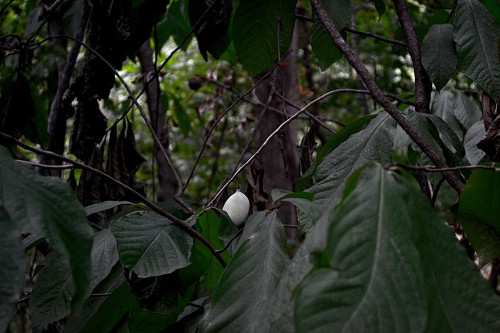 There’s an excellent website that says they are “native to the temperate woodlands of the eastern U.S. The American Indian is credited with spreading the pawpaw across the eastern U.S. to eastern Kansas and Texas, and from the Great Lakes almost to the Gulf. Fossils prove the pawpaw is indigenous to the U.S.”
There’s an excellent website that says they are “native to the temperate woodlands of the eastern U.S. The American Indian is credited with spreading the pawpaw across the eastern U.S. to eastern Kansas and Texas, and from the Great Lakes almost to the Gulf. Fossils prove the pawpaw is indigenous to the U.S.”
The ones in our back yard have a less exciting origin than being spread by American Indians. Mother said forty-plus years ago Dad brought home a big batch of them from a jobsite. After we had eaten all (more) than we wanted, he pitched the remainder over the fence into the cow pasture behind us.
How do pawpaws grow?
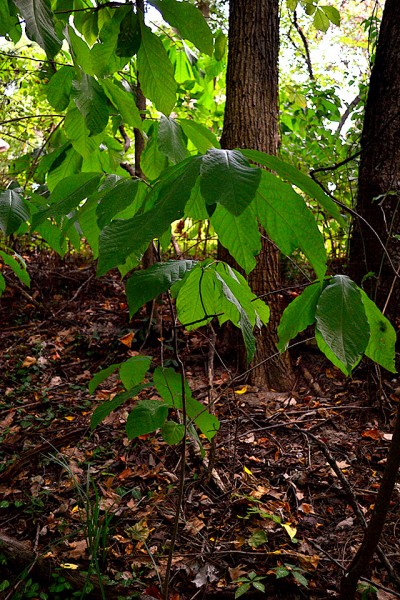 Dad didn’t know it, but he pitched them in just about a perfect place for them to grow. The website says they prefer a humid continental climate. The young plant requires filtered sun for its first year or two. Once established, they prefer full sun. That probably explains why our trees never got too big: they were too shaded by the walnut trees. Because they are on a fairly steep hillside, they stay well-drained. Years and years of being used as a cow pasture provided them with plenty of “organic fertilizer high in potassium.”
Dad didn’t know it, but he pitched them in just about a perfect place for them to grow. The website says they prefer a humid continental climate. The young plant requires filtered sun for its first year or two. Once established, they prefer full sun. That probably explains why our trees never got too big: they were too shaded by the walnut trees. Because they are on a fairly steep hillside, they stay well-drained. Years and years of being used as a cow pasture provided them with plenty of “organic fertilizer high in potassium.”
I had never considered cold to be essential to plant growth, but pawpaws “require a minimum of 400 hours of winter chill and at least 160 frost-free days.” To break dormancy, the site says, the seeds require exposure to cold temperatures for 90 to 120 days.
Fruit looks a little like a mango
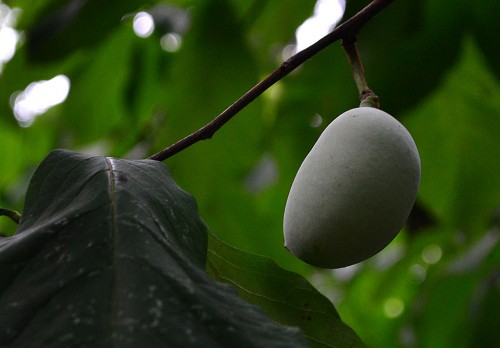 Gardener Lila has several good photos of the mangoes in our back yard in Florida here and here. Pawpaws don’t grow as large as our mangoes, though; they top out at 5 to 16 ounces and three to six inches in length. The pawpaws also have that elongated peanut shape when they’re ripe.
Gardener Lila has several good photos of the mangoes in our back yard in Florida here and here. Pawpaws don’t grow as large as our mangoes, though; they top out at 5 to 16 ounces and three to six inches in length. The pawpaws also have that elongated peanut shape when they’re ripe.
Chiggers have been waiting
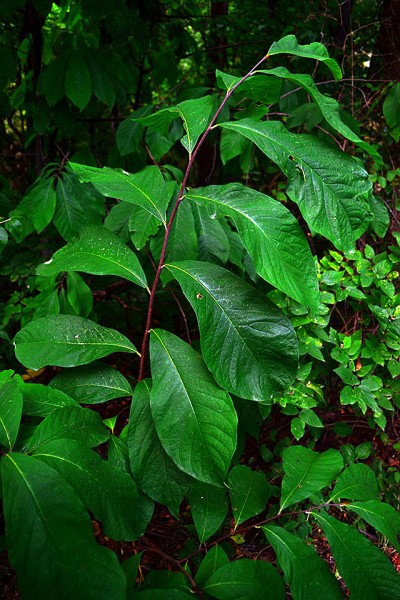 There’s still a little bit of the old wire fencing separating our yard from the former cow pasture. My buddies and I used to climb it frequently to roam and camp in Mr. Hale’s fields. I couldn’t get a good angle for my photos, so I tentatively climbed up on the fence just like I had when I was 10 years old. Mr. Hale bought a good brand of fence, because it was still sturdy enough to hold my weight. It’s comforting to know that I can still climb a fence. (He had a couple of bulls that offered encouragement for doing it quickly when I was a kid.)
There’s still a little bit of the old wire fencing separating our yard from the former cow pasture. My buddies and I used to climb it frequently to roam and camp in Mr. Hale’s fields. I couldn’t get a good angle for my photos, so I tentatively climbed up on the fence just like I had when I was 10 years old. Mr. Hale bought a good brand of fence, because it was still sturdy enough to hold my weight. It’s comforting to know that I can still climb a fence. (He had a couple of bulls that offered encouragement for doing it quickly when I was a kid.)
The local chigger contingent must have remembered how tender that 10 year-old-boy was and put out the word that he was back after half a century. I was down in their neighborhood for no more than 15 minutes, but I picked up at least half a dozen hitchhikers behind my knees and thighs that kept me itching for a week.
My readers must like me to suffer. Some of you were kind enough to punch the DONATE button at the top left of the page after I told the sad story of my bee encounter at Franklin School. The bee that left his stinger in my upper lip hurt a lot more, but those chigger bites drove me crazy night and day, no matter what concoctions I slathered on them. Hint, hint.

Ken, next time you get chiggers, put clear fingernail polish on them. Cuts the air supply off and they die.
Never worked for me. I think the little buggers carry snorkels.
Often wondered how PawPaw, Illinois, got its name. When it in snowing in April in Wisconsin, I try to remind myself that we don’t have chiggers or poisonous snakes in our vicinity.
Thanks, Ken. Since you bought up the subject of PawPaws, I “googled” to learn more and there was more on the subject then I thought I would ever want to know. I think I may have to get a couple of trees to add to the mix of trees on my property. I even have a bit of old barb wire fencing that separates the back of my property from the neighboring Christmas Tree farm. From your description of the location of your Cape tree, seems like a perfect place to plant! May look around first, it took me eight years to discover I had a persimmon tree near the front, by the road.
Donate for Chigger bites…I want to see blood before gold passes from my hands! Now if you got and infection and lost arm or leg then maybe…
Paw Paws are good eating…I remember finding them in the woods on Mississippi Street. Sweet and soft they were
You’re a tough crowd. Can I offer up the story about my poor mother’s arm?
Love the Paw Paw story!! Try Chigarid for your chiggers!! I am a chigger magnet and this is the ONLY thing that helps!! Trust me, I can step off of the concrete and the chiggers find me so I usually go thru at least 2 bottles of Chigarid a summer!! It will help!
I’m pretty sure that’s what I tried. I looked in my shaving kit, but I must have left the container behind in MO because I wouldn’t need it down here.
Ken,
My husband was an outdoor guy. The chiggers seem to stalk him. A friend shared with him this remedy, that you might want to try. As soon as he came indoors, he would hit the shower. Before the shower he would rub white vinegar all over. It seemed to work for him. I too have tried it on my legs and feet. Trust me the vinegar does not leave a smell after the shower. ha-ha The vinegar was an inexpensive remedy that seemed to work for us.
Chiggers love me too. I can’t seem to escape them here in MO. I have found that applying Skin so Soft by Avon on my arms and legs before going outside keep them away.